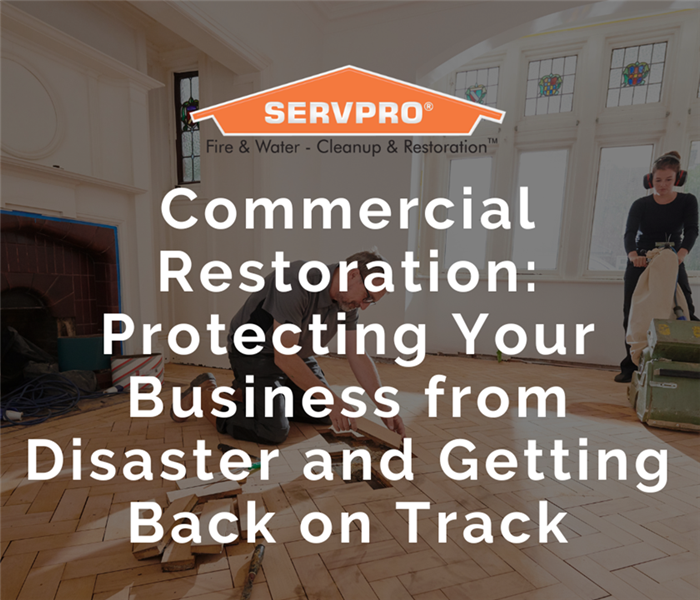Commercial Restoration: Protecting Your Business from Disaster and Getting Back on Track
12/17/2024 (Permalink)
 At Norwood/West Roxbury, we combine advanced training with industry-leading equipment to restore your business efficiently and effectively.
At Norwood/West Roxbury, we combine advanced training with industry-leading equipment to restore your business efficiently and effectively.
When disaster strikes—whether from water, fire, mold, or severe weather—the consequences can feel overwhelming. Beyond disrupting daily operations, the damage can impact your employees, customers, and bottom line. Swift commercial restoration is essential to help businesses recover quickly and effectively. This guide explores the restoration process, common types of damage, and proactive steps to safeguard your business against future disasters.
Why Commercial Restoration is Crucial
Every moment your business remains closed translates to lost revenue and productivity. Rapid restoration minimizes disruption, helping your business rebound while ensuring a safe environment for employees and customers. Expert restoration teams handle cleanup, repairs, and prevention, allowing you to focus on rebuilding with confidence.
Common Types of Commercial Damage
Water Damage
- Causes: Burst pipes, roof leaks, flooding, or faulty sprinkler systems.
- Impact: Leads to mold growth, structural damage, and ruined equipment or inventory.
- Restoration Process: Includes water extraction, drying, dehumidification, and thorough monitoring to eliminate residual moisture.
Fire and Smoke Damage
- Causes: Electrical malfunctions, kitchen fires, or industrial accidents.
- Impact: Fire often leaves behind smoke, soot, and odors that require specialized treatment.
- Restoration Process: Soot removal, deodorizing, and deep-cleaning to prevent further damage to walls, furniture, and equipment.
Mold and Fungal Growth
- Causes: High humidity, previous water damage, or poor ventilation.
- Impact: Damages walls, floors, and HVAC systems while posing health risks.
- Restoration Process: Includes containment, air filtration, mold removal, and preventative measures to stop future growth.
Storm and Wind Damage
- Causes: Hurricanes, tornadoes, heavy rains, and high winds.
- Impact: Broken windows, roof leaks, downed trees, and flooded areas.
- Restoration Process: Structural repairs, debris removal, water extraction, and necessary construction.
The Commercial Restoration Process
1. Assessment and Inspection
- On-site evaluations determine the extent of damage and create a tailored restoration plan.
- May include moisture mapping, air quality testing, and structural inspections.
2. Mitigation and Containment
- Immediate actions to prevent further damage, such as boarding windows or tarping roofs.
- For water or mold damage, this includes water extraction and dehumidification.
3. Cleanup and Removal
- Damaged materials (e.g., drywall, flooring, furniture) are removed.
- Specialized cleaning eliminates soot, mold, and water residue, ensuring safety.
4. Restoration and Repair
- Repairs and replacements include structural rebuilding, repainting, and refinishing.
- Odor removal and deep cleaning ensure a safe, welcoming environment.
5. Final Inspection and Prevention Recommendations
- Comprehensive inspections confirm the property is fully restored.
- Experts often suggest preventative upgrades like fireproofing or moisture control.
Choosing a Reliable Restoration Partner
Selecting the right restoration company is crucial for seamless recovery. Look for a provider with:
- 24/7 Availability: Fast response times are vital to minimizing damage.
- Advanced Equipment: Commercial spaces often require specialized tools and techniques.
- Knowledge of Codes: Compliance with local regulations ensures safety and avoids legal issues.
- Project Management Expertise: Coordinating contractors, permits, and inspections simplifies complex restoration efforts.
Preparing Your Business for Future Disasters
1. Conduct Regular Maintenance
- Inspect plumbing, HVAC, electrical, and roofing systems to address issues early.
2. Improve Waterproofing
- Seal foundation cracks, ensure proper drainage, and consider water-resistant barriers.
3. Develop a Disaster Plan
- Outline evacuation routes, emergency contacts, and data protection measures.
4. Upgrade Fire Safety Systems
- Test alarms, sprinklers, and extinguishers to meet current standards.
5. Review Insurance Coverage
- Ensure your policy includes disaster recovery and business interruption coverage.
Facing a disaster can be challenging, but with the right team and preparation, your business can recover quickly. Whether dealing with water, fire, mold, or storm damage, proactive planning and quick restoration ensure minimal disruption and a smoother return to normal operations.
At Norwood/West Roxbury, we combine advanced training with industry-leading equipment to restore your business efficiently and effectively.





 24/7 Emergency Service
24/7 Emergency Service